Ecological Landscape Design is a design perspective that views all landscapes as part of a greater, interconnected ecosystem. No matter the size of the garden or property, what we design, plant, and maintain has a ripple effect on the surrounding environment and broader ecosystem health. In the below video, Jay Archer explains our objectives as ecological landscape designers to use our design and construction skills to create highly functioning, biodiverse ecosystems.
Functional, Holistic & Environmentally Friendly Landscape Design
When we think about design goals, for any project, there are three main threads: our client’s health and wellbeing, the direct local environment, and the broader ecosystem. This may seem ambitious for residential landscape design, but the beauty of ecological landscape design is its ability to solve for a multitude of different problems at the same time.
Healthy Lifestyle Shifts with Landscape Design
Every design starts with the client –understanding their direct needs and objectives, and what they might not know they need from a landscape design. What starts out as a singular goal can be expanded upon to improve overall lifestyle and human health.
For example, we may get a call about a landscape renovation because all the foundation plantings are 30+ years old and overgrown. The client wishes to change the landscape aesthetic but may not realize that these overgrown plantings close to the home also restrict air circulation and create conditions for mold growth, which creates a respiratory hazard. We come to a consensus with the client about what needs to be changed and offer design solutions that deliver on many more ecological landscape design objectives.
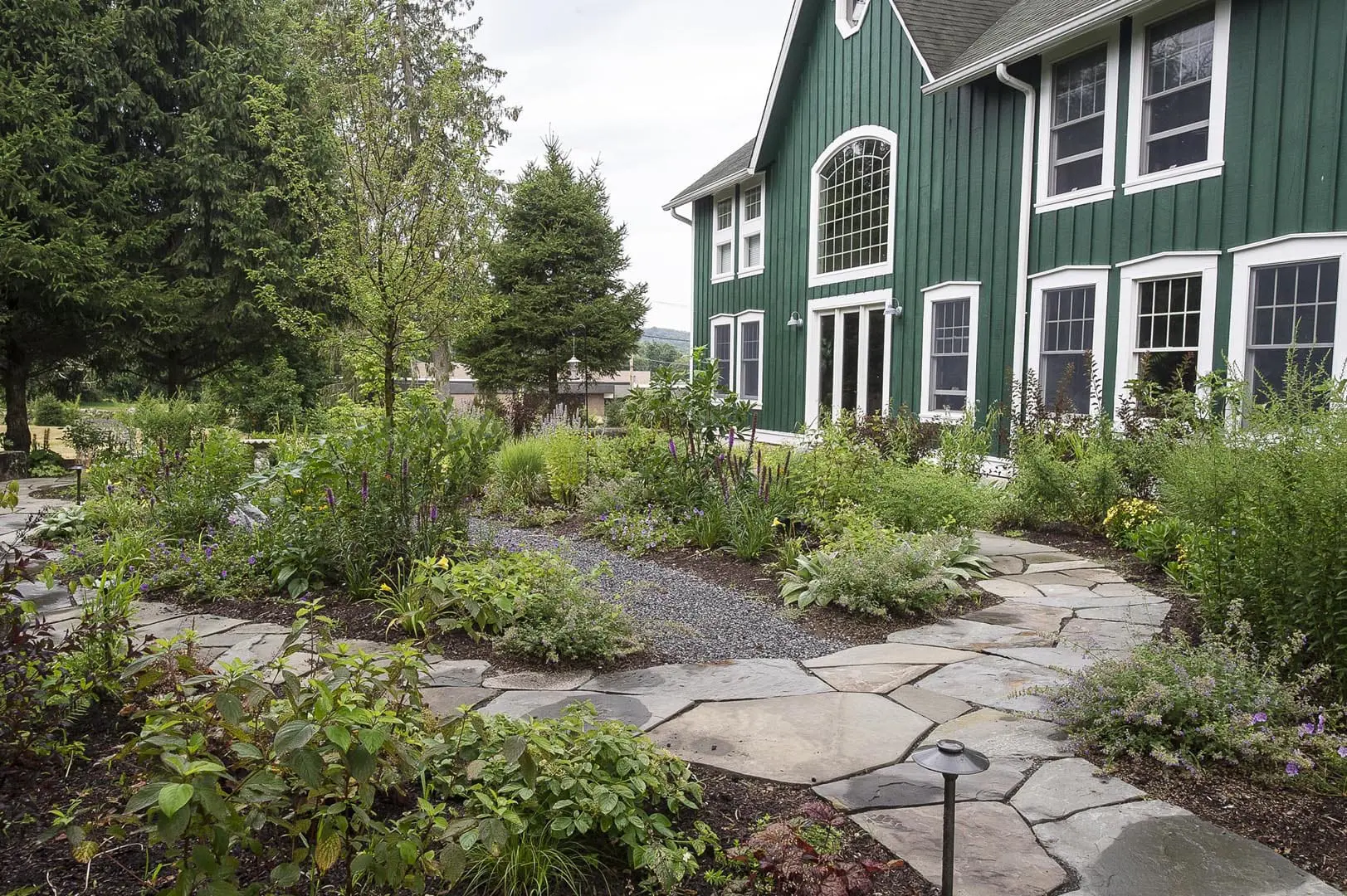
This requires critical thinking about the function of each landscape element. Foundation plantings have been the norm for so long in the landscape industry, but we find they can detract from a home’s architecture, are often planted too close to the structure, and are almost always exotic plants that offer no ecosystem services.
Instead of simply replacing foundation plantings, we can rethink where plant material is most needed on a property to suit the clients’ lifestyle. Perhaps native shrub islands or a faux meadow garden in the backyard will attract the client to a previously neglected part of their property. Designing a space for strolls through the landscape or quiet moments of reflection in the garden has immense physiological and mental health benefits.
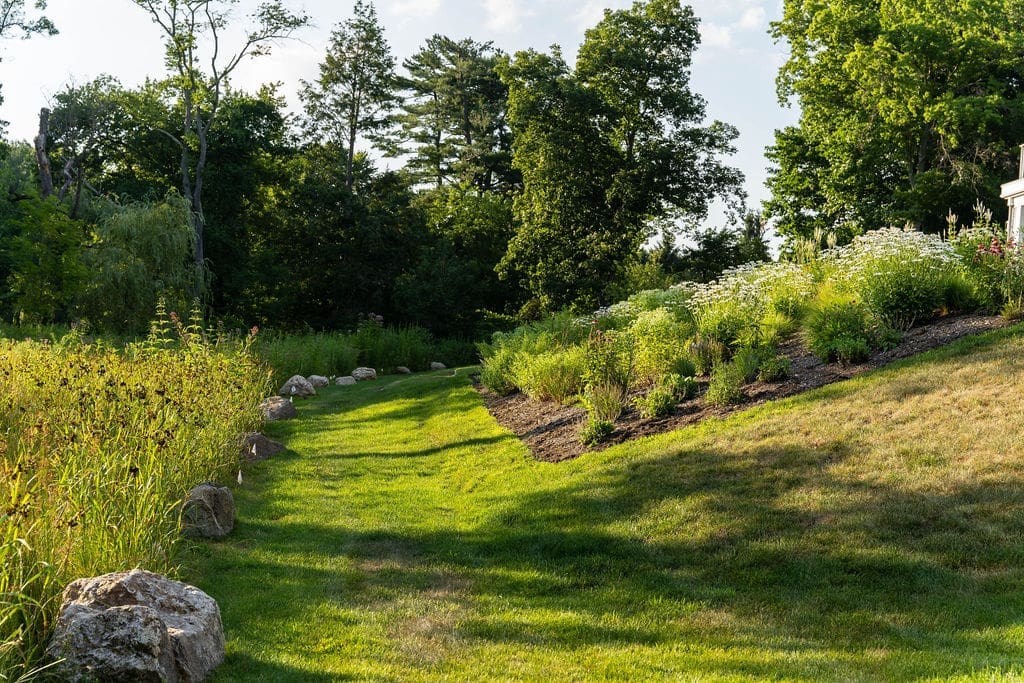
As ecological landscape designers, we seek to reintegrate our clients with the natural world, because we know of its healing powers! From plant polyphenols and soil microbes that reduce stress, to the soothing qualities of bird song and trickling water, we are acutely aware of how design elements can shift a lifestyle and improve human health. Learn more about the connection between soil and human health on our previous blog.
Environmentally Friendly Landscaping
Once the spatial layout and landscape function has been explored, fleshing out the design with green infrastructure and native plants helps us achieve local environmental goals.
For example, it is highly likely that the previous landscape was treated with synthetic chemicals and therefore has virtually sterile soil, devoid of microbes. By amending the soil and cultivating soil microbes, we drastically improve the performance of the landscape.
Soil microbes improve plant health and immunity, absorb stormwater better, and make plants more resilient in tough growing conditions. We are designing a local environment that is more self-sustaining than traditional, exotic landscape plants.
Another local environmental goal that can be achieved at the residential level is water conservation. How water is directed, filtered, and absorbed through a landscape has a direct effect on how much stormwater can recharge our aquifers vs. gather pollutants and discharge into larger water bodies.
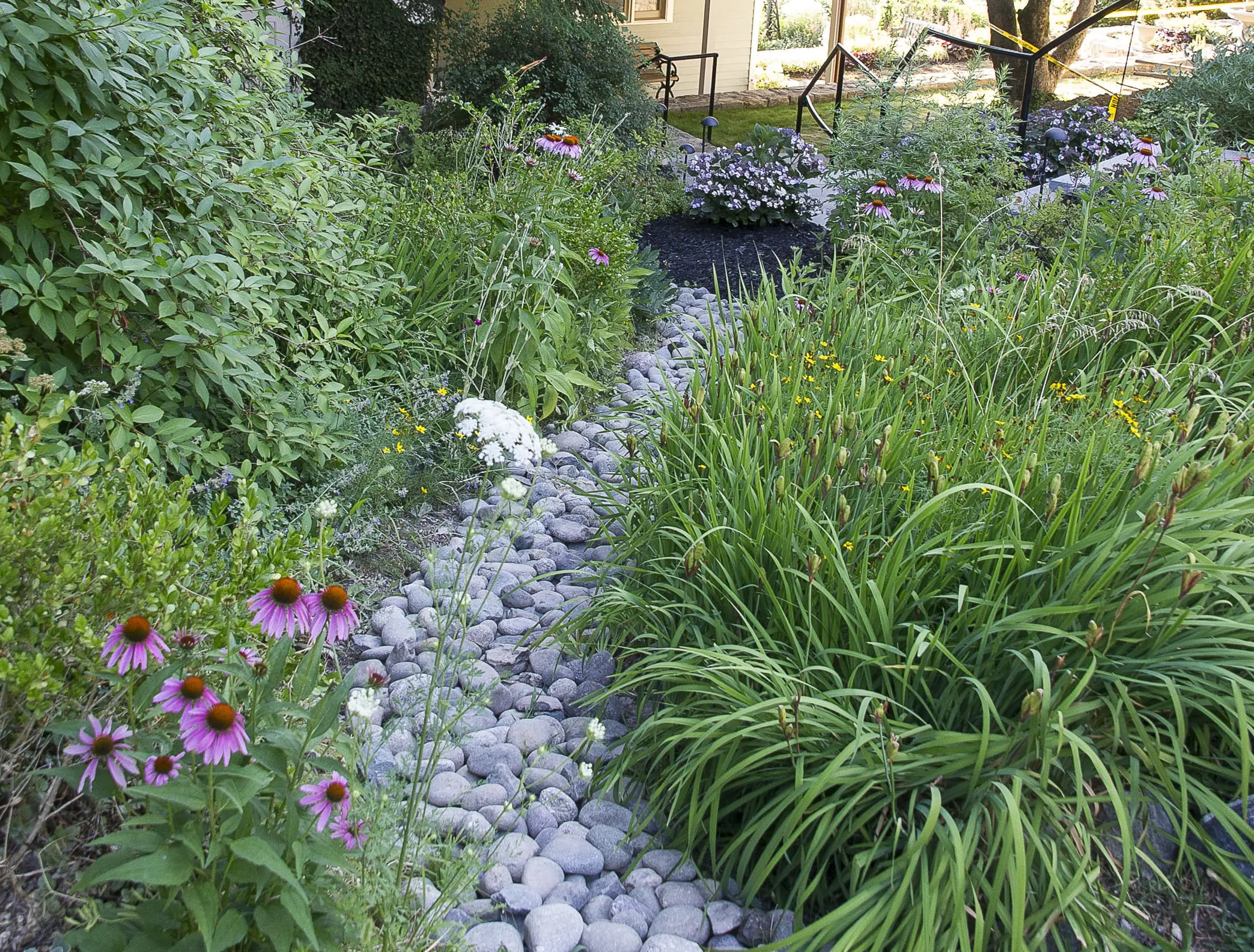
We examine landscape drainage on every property and are always seeking to improve absorption, rainwater harvesting and rainwater recycling with Low Impact Design (LID). This can include rain barrels that connect to irrigation, rain gardens that absorb stormwater and create habitat, or bioswales that direct stormwater to an underground holding area.
Water conservation and soil conservation are inextricably related, especially at the local level. Stormwater runoff contributes to soil erosion, so by designing for stormwater absorption, we can simultaneously meet goals to retain soil, which in turn makes our landscape plantings healthier and more resilient. By facing stormwater management head on at the residential level, we are improving the local water supply, watershed, and capacity for plant habitat.
Tackling Ecosystem-Level Goals with Residential Landscape Design
Hyper-local, residential planting and maintenance choices also affect the broader ecosystem. By planting native plants, we are creating habitat at home – extending existing biotic corridors through developed areas, one yard at a time. As we face what is known as the Sixth Great Extinction –a drastic loss of species, especially insects, in the last 50 years — planting for biodiversity is more important than ever.
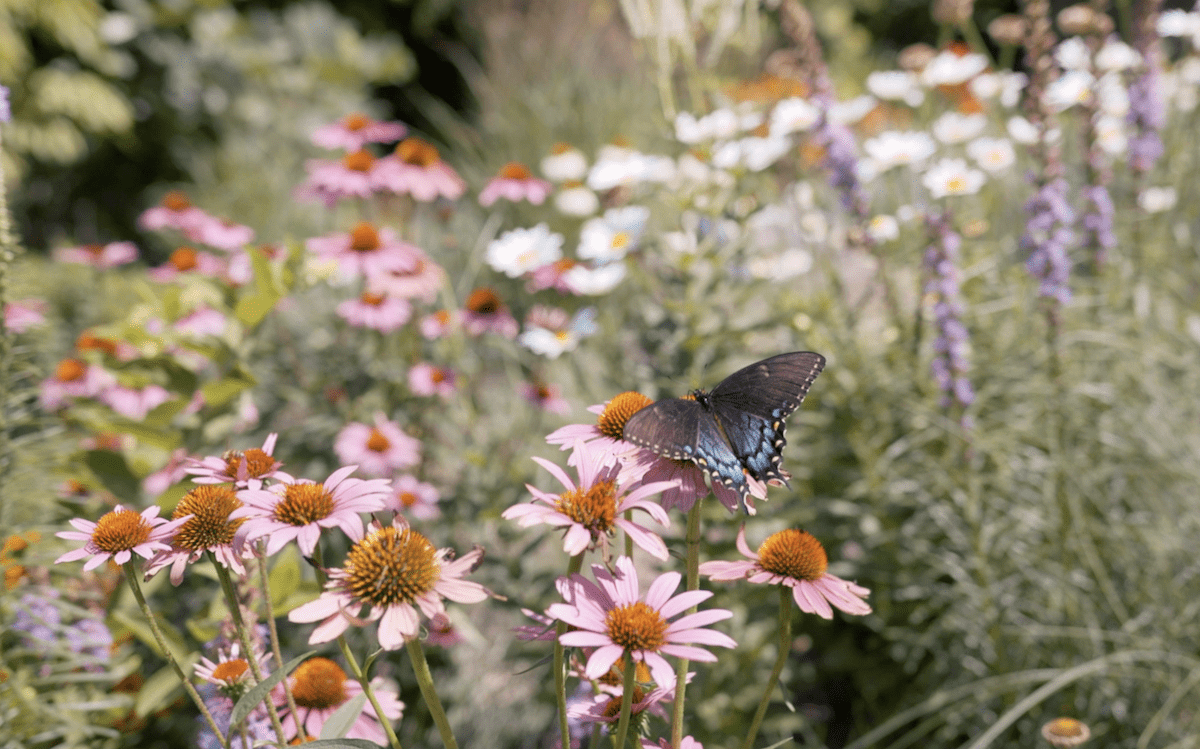
The best way to create a biodiverse habitat is to plant a variety of native plants that fulfil different habitat needs. Plants have unique pollinating syndromes (flowering attributes) that evolved alongside specific pollinators to maximize pollination and nutrition uptake, respectively.
According to the University of Massachusetts:
Beetles often pollinate more open flowers while butterflies visit narrow tubular flowers with landing pads. Bees pollinate shallow tubular flowers with landing platforms. Birds pollinate funnel shaped flowers or cup-shaped flowers that have a strong perch support. Flies pollinate shallow flowers that are funnel-like or flowers with floral features that trap the flies. Moths pollinate tubular flowers without a lip.
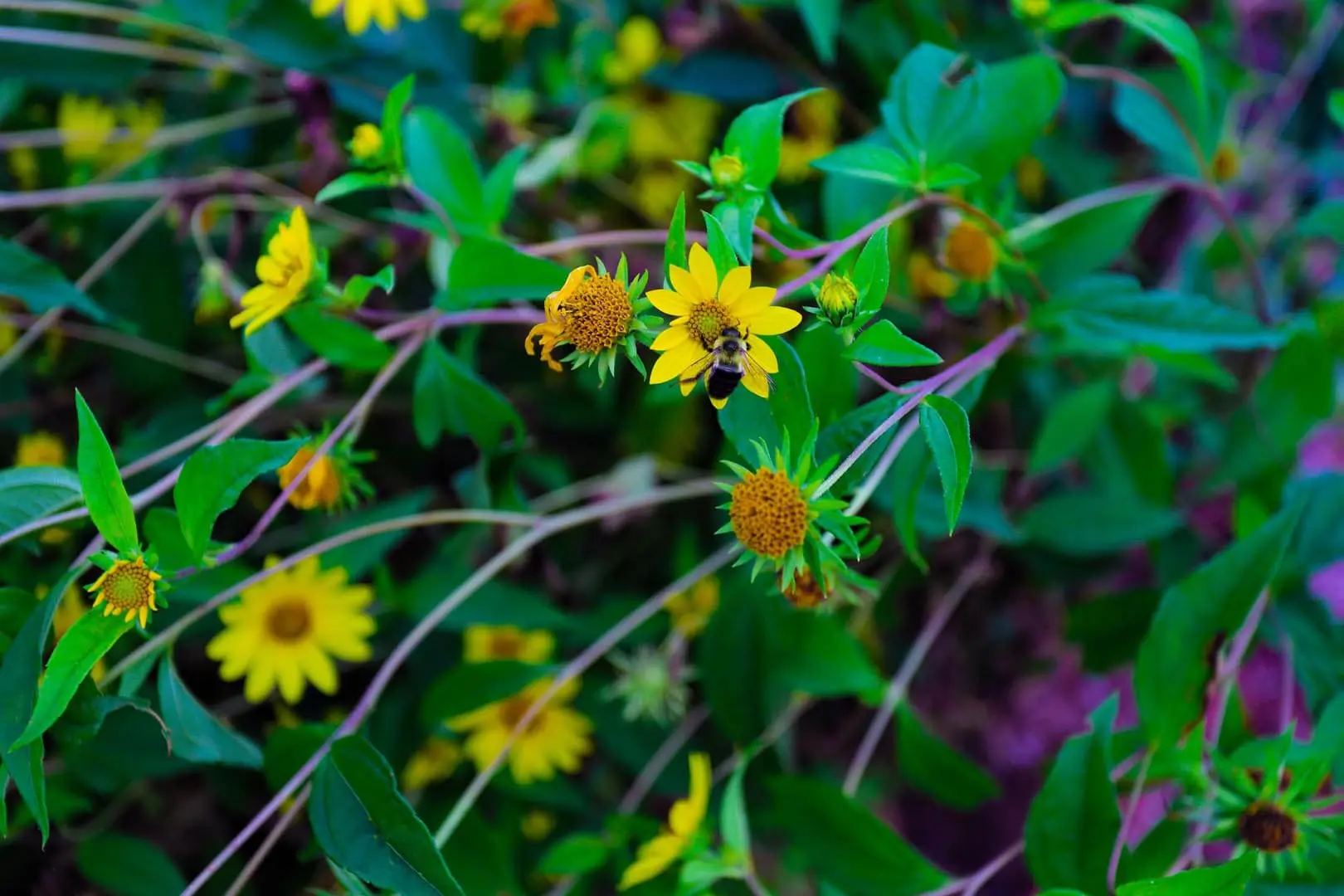
Plant selection from an ecological landscape perspective must be varied enough to create a comprehensive habitat, while also maintaining aesthetic cohesiveness. Beauty and function. Aside from pollinating syndrome diversity, an ecological planting must have a sequence of pollen/nectar, seedheads and berries to provide food sources throughout the year. Native trees, shrubs, grasses, and pollinator stems also provide nesting materials and space for wildlife. Bird baths, ponds or streams offer essential water and bathing sources.
By prioritizing native plants and reframing our concept of beauty in our landscapes, we can achieve impressive environmental goals at both the micro and macro scale. Check out Doug Tallamy’s Homegrown National Park for an example of power in numbers and grass roots environmentalism.
Ecological Landscape Design for a Resilient Future
As you can see, our goals are lofty as ecological landscape designers. We wouldn’t have it any other way. Setting ambitious targets for environmental improvements through local landscape design makes our work fulfilling and meaningful, allowing us to give back to our community and Mother Nature again and again. If these values resonate with you, we’d love to work with you! Schedule a consultation or fifteen-minute discovery call here.
—
Green Jay Landscape Design
Where Design Meets Ecology
914.560.6570